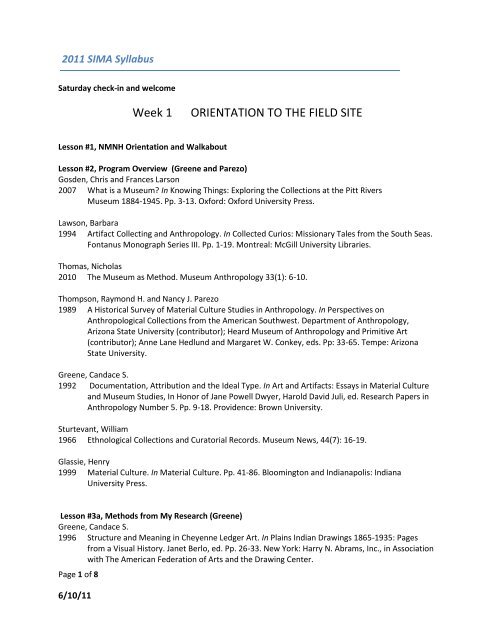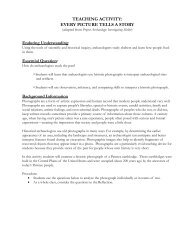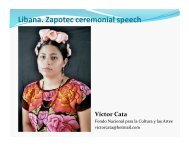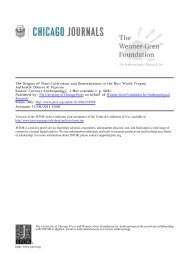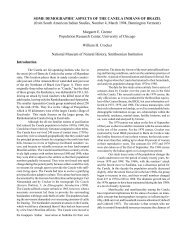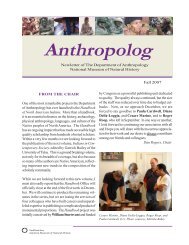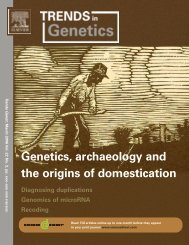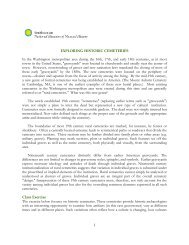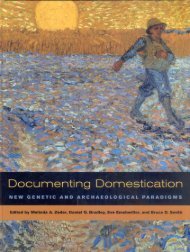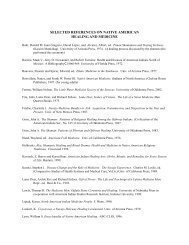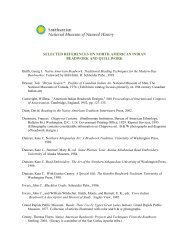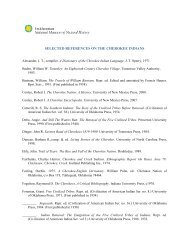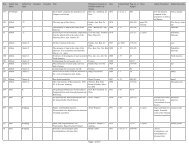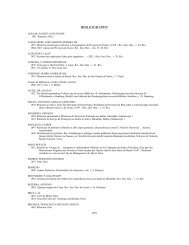Week 1 ORIENTATION TO THE FIELD SITE - Anthropology ...
Week 1 ORIENTATION TO THE FIELD SITE - Anthropology ...
Week 1 ORIENTATION TO THE FIELD SITE - Anthropology ...
You also want an ePaper? Increase the reach of your titles
YUMPU automatically turns print PDFs into web optimized ePapers that Google loves.
2011 SIMA Syllabus<br />
Saturday check-in and welcome<br />
Page 1 of 8<br />
6/10/11<br />
<strong>Week</strong> 1 <strong>ORIENTATION</strong> <strong>TO</strong> <strong>THE</strong> <strong>FIELD</strong> <strong>SITE</strong><br />
Lesson #1, NMNH Orientation and Walkabout<br />
Lesson #2, Program Overview (Greene and Parezo)<br />
Gosden, Chris and Frances Larson<br />
2007 What is a Museum? In Knowing Things: Exploring the Collections at the Pitt Rivers<br />
Museum 1884-1945. Pp. 3-13. Oxford: Oxford University Press.<br />
Lawson, Barbara<br />
1994 Artifact Collecting and <strong>Anthropology</strong>. In Collected Curios: Missionary Tales from the South Seas.<br />
Fontanus Monograph Series III. Pp. 1-19. Montreal: McGill University Libraries.<br />
Thomas, Nicholas<br />
2010 The Museum as Method. Museum <strong>Anthropology</strong> 33(1): 6-10.<br />
Thompson, Raymond H. and Nancy J. Parezo<br />
1989 A Historical Survey of Material Culture Studies in <strong>Anthropology</strong>. In Perspectives on<br />
Anthropological Collections from the American Southwest. Department of <strong>Anthropology</strong>,<br />
Arizona State University (contributor); Heard Museum of <strong>Anthropology</strong> and Primitive Art<br />
(contributor); Anne Lane Hedlund and Margaret W. Conkey, eds. Pp: 33-65. Tempe: Arizona<br />
State University.<br />
Greene, Candace S.<br />
1992 Documentation, Attribution and the Ideal Type. In Art and Artifacts: Essays in Material Culture<br />
and Museum Studies, In Honor of Jane Powell Dwyer, Harold David Juli, ed. Research Papers in<br />
<strong>Anthropology</strong> Number 5. Pp. 9-18. Providence: Brown University.<br />
Sturtevant, William<br />
1966 Ethnological Collections and Curatorial Records. Museum News, 44(7): 16-19.<br />
Glassie, Henry<br />
1999 Material Culture. In Material Culture. Pp. 41-86. Bloomington and Indianapolis: Indiana<br />
University Press.<br />
Lesson #3a, Methods from My Research (Greene)<br />
Greene, Candace S.<br />
1996 Structure and Meaning in Cheyenne Ledger Art. In Plains Indian Drawings 1865-1935: Pages<br />
from a Visual History. Janet Berlo, ed. Pp. 26-33. New York: Harry N. Abrams, Inc., in Association<br />
with The American Federation of Arts and the Drawing Center.
Greene, Candace S.<br />
2009 One Hundred Summers: A Kiowa Calendar Record. University of Nebraska Press. (selections)<br />
Lesson #3b, Methods from My Research (Parezo)<br />
Parezo, Nancy<br />
1982 Navajo Sandpaintings: The Importance of Sex Roles in Craft Production. The American Indian<br />
Quarterly 66(1-2): 125-148.<br />
2001 The “Shy” Cocopa Go to the Fair IN Selling the Indian: Commercializing and Appropriating<br />
American Indian Cultures, edited by Carter Jones Meyer and Diana Royer, pp.3-43. Tucson:<br />
University of Arizona Press, (with John W. Troutman).<br />
Parezo, Nancy J., Hays, Kelley A., and Barbara F. Slivac<br />
1987 The Mind's Road. Southwest Indian Women's Art. In The Desert Is No Lady: Southwestern<br />
Landscapes in Women's Writing and Art. Vera H. Norwood and Janice Monk, eds. Pp.146-<br />
173. New Haven: Yale University Press.<br />
Lesson #4, EMu Database Orientation<br />
Lesson #5, Collections Resources: Artifacts (Greene)<br />
Guide to Collections Records, Ethnology and Archaeology Collections. Smithsonian Institution,<br />
National Museum of Natural History, Department of <strong>Anthropology</strong>.<br />
Jones, Reba<br />
1998 Handling. In The New Museum Registration Methods. 4 th edition. Rebecca A. Buck and Jean<br />
AllmanGilmore, eds. Pp. 45-48. Washington, DC: American Association of Museums.<br />
Lesson #6, SIRIS Database Orientation<br />
Lesson #7, Collections Resources: Archives (Parezo)<br />
Brettell, Caroline B.<br />
1998 Fieldwork in the Archives: Methods and Sources in Historical <strong>Anthropology</strong>. In Handbook of<br />
Methods in Cultural <strong>Anthropology</strong>. H. Russell Bernard, ed. Pp. 513-45. Walnut Creek, CA:<br />
AltaMira Press.<br />
Parezo, Nancy<br />
1996 The Formation of Anthropological Archival Records. In Learning from Things: Method and<br />
Theory of Material Culture Studies. W. David Kingery, ed. Pp.145-172. Washington, DC:<br />
Smithsonian Institution Press.<br />
Finnegan, Ruth<br />
1996 Using Documents. In Data Collection and Analysis. R Sapsford and V Jupp, eds. Pp. 138-151.<br />
London: Sage Publications.<br />
Lutkehaus, Nancy<br />
1990 Refractions of Reality: On the Use of Other Ethnographers’ Fieldnotes. In Fieldnotes: The<br />
Makings of <strong>Anthropology</strong>. Roger Sanjek, ed. Pp.303-323. Ithaca: Cornell University Press.<br />
Page 2 of 8<br />
6/10/11
Lesson #8, Photographing Collections (NMNH Photographer Don Hurlbert)<br />
Lesson #9, Collections Notes (Greene and Parezo)<br />
Sanjek, Roger<br />
1990 A Vocabulary for Fieldnotes. In Fieldnotes: The Makings of <strong>Anthropology</strong>. Roger Sanjek, ed.<br />
Pp.92-121. Ithaca: Cornell University Press.<br />
Lesson #10, Methods from My Research (Isaac)<br />
Deetz, James<br />
1977 In Small Things Forgotten: The Archaeology of Early American Life. Pp. 64-90. New York:<br />
Doubleday.<br />
Isaac, Gwyneira<br />
2011 Whose Idea Was This? Current <strong>Anthropology</strong> 52(2): 211-233.<br />
2005 Re-Observation and the Recognition of Change: The Photographs of Matilda Coxe Stevenson<br />
(1879-1915). Journal of the Southwest 47(3): 411-455.<br />
Lesson #11, Methods from My Research (Bell)<br />
Bell, Joshua A.<br />
2009 Documenting discontent: Struggles for recognition in the Purari Delta of Papua New Guinea. The<br />
Australian Journal of <strong>Anthropology</strong> 20(1): 28-47.<br />
2006 Losing the Forest But Not the Stories in the Trees: Contemporary Understandings of the<br />
Government Anthropologist F.E. Williams. 1922 Photographs of the Purari Delta, Papua New<br />
Guinea. Journal of Pacific History 41(2): 191-206.<br />
Lesson #12, Methods from My Research (Glass)<br />
Readings:<br />
Glass, Aaron<br />
2009 A Cannibal in the Archive: Performance, Materiality, and (In)Visibility in Unpublished Edward<br />
Curtis Photographs of the Kwakwaka’wakw Hamat’sa. Visual <strong>Anthropology</strong> Review 25(2):128-<br />
149.<br />
2006 From Cultural Salvage to Brokerage: The Mythologization of Mungo Martin and the Emergence<br />
of Northwest Coast Art. Museum <strong>Anthropology</strong> 29(1): 20-43.<br />
2009 Frozen Poses: Hamat’sa Dioramas, Recursive Representation, and the Making of a<br />
Kwakwaka’wakh Icon. In Photography, <strong>Anthropology</strong> and History: Expanding the Frame.<br />
Christopher A. Morton and Elizabeth Edwards, eds. Pp. 89-116. Burlington: Ashgate Publishing.<br />
2004 Intention of Tradition: Contemporary Contexts and Contests of the Hamat’sa Dance. In Coming<br />
to Shore: Northwest Coast Ethnology, Traditions, and Visions. Marie Mauzé, Michael E. Harkin,<br />
and Sergei Kan, eds. Pp. 279-303. Lincoln and London: University of Nebraska Press.<br />
Lesson #13, <strong>Week</strong>ly Data Collection Plans (Greene)<br />
Page 3 of 8<br />
6/10/11
Lesson #14, Smithsonian Folklife Festival (Godby Ingalsbe)<br />
Glassie, Henry<br />
1997 Shankharibazar. In Art and Life in Bangladesh. Pp. 307-366. Bloomington: Indiana University<br />
Press.<br />
Kurin, Richard.<br />
1989 Why We Do the Festival. In Festival of American Folklife Program. Washington, D.C.:<br />
Smithsonian Institution and National Park Service.<br />
Lesson #14 Follow-up<br />
Page 4 of 8<br />
6/10/11<br />
<strong>Week</strong> 2 VISUAL COMPETENCY: LEARNING <strong>TO</strong> LOOK<br />
Lesson #15, Meet & Greet SI Resource People<br />
Lesson #16, Close Looking: Single Objects (Greene)<br />
Banks, Marcus<br />
2001 Reading Pictures. In Visual Methods in Social Research. Pp. 1-12. Los Angeles and London: Sage<br />
Publications.<br />
Caple, Chris<br />
2006 Investigating Objects: Theories and Approaches. In Objects: Reluctant Witnesses to the Past. Pp.<br />
1-43. London and New York: Routledge.<br />
Doyle, Sir Arthur Conan<br />
1890 The Science of Deduction. In The Sign of the Four. http://www.gutenberg.org/files/2097/2097h/2097-h.htm#chap01<br />
.<br />
Prown , Jules David<br />
1982 Mind in Matter: An Introduction to Material Culture Theory and Method. Winterthur Portfolio<br />
17(1):1-19.<br />
Lesson #17, Looking at Assemblages: African Baskets (Arnoldi)<br />
Arth, Kim<br />
2005 Keeping Traditions: Change, Innovation and Continuity in Kenyan Kyondo Baskets (Master’s<br />
Thesis)<br />
Lesson #18, Looking at Photographs and Film as Objects (Bell)<br />
Edwards, E. and J. Hart<br />
2004 Introduction: Photographs as Objects. In Photographs Objects Histories: On the Materiality of<br />
Images. E. Edwards and J.Hart, eds. Pp. 1-16. London: Routledge.<br />
Morton, Christopher and Elizabeth Edwards
2009 Introduction. In Photography, <strong>Anthropology</strong> and History: Expanding the Frame. Christopher<br />
Morton and Elizabeth Edwards, eds. Pp.1-24. Burlington: Ashgate Publishing Company.<br />
Pinney, Christopher<br />
1992 The Parallel Histories of <strong>Anthropology</strong> and Photography. In <strong>Anthropology</strong> and Photography<br />
1860-1920. Elizabeth Edwards, ed. Pp 74-95. New Haven: Yale University Press.<br />
Lesson #19, Looking Small, Looking Large: Totem Poles (Glass)<br />
Reading:<br />
Glass, Aaron and Aldona Jonaitis<br />
(In press) A Miniature History of Model Totem Poles. In Carvings and Commerce: Model Totem<br />
Poles 1880-2010. Medel Art Gallery and University of Washington Press.<br />
Hawker, Ronald<br />
2003 Northwest Coast Art as National Heritage: Two Federal Projects of the Late 1920s. In Tales of<br />
Ghosts: First Nations Art in British Columbia, 1922-1961. Pp. 46-65. Vancouver: UBC Press.<br />
Jonaitis, Aldona and Aaron Glass<br />
2010 Chapter 3. In The Totem Pole: An Intercultural History. Seattle: University of Washington Press.<br />
Moore, Emily<br />
2010 Propatriation: Possibilities for Art after NAGPRA. Museum <strong>Anthropology</strong> 33(2):125-136.<br />
Nuytten, Phil<br />
1982 Part 2: Ellen Neel. In The Totem Carvers. Pp. 43-74. Vancouver: Panorama Publications Ltd.<br />
Lesson #20, Distinguished Lectures in Museum <strong>Anthropology</strong> – Aaron Glass<br />
Page 5 of 8<br />
6/10/11<br />
<strong>Week</strong> 3 HOW COLLECTIONS ARE SHAPED: DATA CRITIQUE<br />
Lesson #21, Methods from My Research (Morphy)<br />
Morphy, Howard<br />
1980 What Circles Look Like. Canberra <strong>Anthropology</strong> 3(1):17-36.<br />
Lesson #22, Who Shapes Collections: James Mooney (Parezo)<br />
Greene, Candace S.<br />
2001 Visions on Shields and Tipis: Kiowa Heraldry. In Silver Horn: Master Illustrator of the Kiowas. Pp.<br />
187-207. Norman: University of Oklahoma Press.<br />
Nason, James D.<br />
1987 The Determination of Significance: Curatorial Research and Private Collections. In Material<br />
<strong>Anthropology</strong>: Contemporary Approaches to Material Culture. Barrie Reynolds and Margaret A.<br />
Stott, eds. Pp.31-67. Lanham: University Press of America.
Welsch, Robert L.<br />
2000 One Time, One Place: Three Collections-Colonial Processes and the Shaping of Some Museum<br />
Collections from German New Guinea. In Hunting the Gatherers: Ethnographic Collectors,<br />
Agents and Agency in Melanesia, 1870s-1930s. Michael O’Hanlon and Robert L. Welsch, eds. Pp.<br />
155-175. New York: Berghahn Books.<br />
Lesson #23, Indigenous Meaning: Navajo Case Study (Parezo)<br />
M’Closkey, Kathy<br />
2004 Towards an Understanding of Navajo Aesthetics.<br />
Accessed 10 June 2011.<br />
Parezo, Nancy<br />
2007 To Live Within Dinétah: Navajo Sandpainters and Their Quest for Place. In Place in Native<br />
American History, Literature and Culture. Papers of the 2006 American Indian Workshop. Joy<br />
Porter, ed. Alexis Kirschbaum, series ed. Pp. 155-176. Witney, Oxfordshire, England: Peter Lang,<br />
Ltd.<br />
Lesson #24, Inscripted Meanings: Objects, Archives, Exhibits (Isaac)<br />
Dening, Greg<br />
1996 Making a Present out of the Past: History’s <strong>Anthropology</strong>. In Performances. Pp. 31 – 63.<br />
University of Chicago Press.<br />
Lesson #25, <strong>Anthropology</strong> of Art (Morphy)<br />
Gell, Alfred<br />
1998 The Problem Defined: The Need for an <strong>Anthropology</strong> of Art. In Art and Agency: An<br />
Anthropological Theory. Pp. 1 – 11. Oxford: Clarendon Press.<br />
Morphy, Howard<br />
2010 Art as Action, Art as Evidence. In Oxford Handbook of Material Culture Studies. Dan Hicks and<br />
Mary C Baudry, eds. Pp. 265-329. Oxford: Oxford University Press.<br />
2009 Art as a Mode of Action: Some Problems with Gell’s Art and Agency. Journal of Material Culture<br />
14(1):5-27.<br />
Lesson #26, Assessing Your Data (Parezo)<br />
Atkinson, Paul and Sara Delamont<br />
2008 Analytical Perspectives. In Collecting and Interpreting Qualitative Materials. 3 rd edition. Norman<br />
K. Denzin and Yvonna S. Lincoln, eds. Pp.285-311. Thousand Oaks: Sage Publications.<br />
Bernard, H. Russell<br />
1994 Coding and Codebooks for Quantitative Data. In Research Methods in <strong>Anthropology</strong>. 2 nd edition.<br />
H. Russell Bernard, ed. Pp. 393-402. Thousand Oaks: Sage Publications<br />
--- Analysis of Qualitative Data. In Research Methods in <strong>Anthropology</strong>. 2 nd edition. H. Russell<br />
Bernard, ed. Pp. 360-392. Thousand Oaks: Sage Publications<br />
Harper, Douglas<br />
2008 What’s New Visually. In Collecting and Interpreting Qualitative Materials. 3 rd edition. Norman K.<br />
Denzin and Yvonna S. Lincoln, eds. Pp.185-204. Thousand Oaks: Sage Publications.<br />
Page 6 of 8<br />
6/10/11
Lesson #27, Understanding Bias (Parezo)<br />
Bernard, H. Russell<br />
1994 Sampling. In Research Methods in <strong>Anthropology</strong>. 2 nd edition. H. Russell Bernard, ed. Pp. 71-101.<br />
Thousand Oaks: Sage Publications.<br />
Fogelson, Raymond D.<br />
1989 The Ethnohistory of Events and Non-Events. Ethnohistory 36(2): 133-147.<br />
Sanjek, Roger<br />
1990 On Ethnographic Validity. In Fieldnotes: The Makings of <strong>Anthropology</strong>. Roger Sanjek, ed. Pp.385-<br />
418. Ithaca: Cornell University Press.<br />
Lesson #28, Nature of Museum Records; Finding More Data (Greene)<br />
Wilcox, U. Vincent<br />
1980 Collections Management with the Computer. Curator 23(1): 43-54.<br />
Lesson #29, Research Funding:<br />
Guest Speaker Deborah Winslow, NSF Cultural <strong>Anthropology</strong> Program Officer<br />
Johnson, Jeffrey C.<br />
1998 Research Design and Research Strategies. In Handbook of Methods in Cultural <strong>Anthropology</strong>.<br />
H.Russell Bernard, ed. Pp. 131-171. Walnut Creek, CA: AltaMira Press.<br />
Parezo, Nancy<br />
1998 Wenner-Gren Foundation grant proposal<br />
Lesson #30, Distinguished Lectures in Museum <strong>Anthropology</strong> – Howard Morphy<br />
Lesson #31, Status Reports from Students<br />
Lesson #33, From Museum to Field: Faculty Roundtable on Working with Source Communities<br />
Bell, Joshua A.<br />
2003 Looking to See: Reflections on Visual Repatriation in the Purari Delta, Gulf Province, Papua New<br />
Guinea. In Museums and Source Communities: A Routledge Reader. Laura Peers and Alison K.<br />
Brown, eds. Pp. 111-122. London and New York: Routledge.<br />
Page 7 of 8<br />
6/10/11<br />
<strong>Week</strong> 4 NEXT STEPS: PROFESSIONAL DEVELOPMENT<br />
Lesson #32, Applying Theory (Parezo)<br />
Castile, George Pierre<br />
1992 Indian Sign: Hegemony and Symbolism in Federal Indian Policy. In State and Reservation: New<br />
Perspectives on Federal Indian Policy. George Pierre Castile and Robert L. Bee, eds. Pp. 165-186.<br />
Tucson: University of Arizona Press.<br />
Anderson, Benedict<br />
1991 Census, Map, Museum. In Imagined Communities: Reflections on the Origin and Spread of<br />
Nationalism. 2 nd edition. London and New York: Verso.
McMullen, Ann<br />
2008 The Currency of Consultation and Collaboration. Museum <strong>Anthropology</strong> Review 2(2): 54-87.<br />
Morphy, Howard<br />
Unpublished Open Access Versus the Culture of Protocols.<br />
Lesson #34, Final Symposium with Student Presentations<br />
Lesson #35, SIMA Course Evaluation<br />
RUNNING THROUGHOUT PROGRAM<br />
Individual advising on research project<br />
Individual data collection, based on weekly data collection plans<br />
Individual time in collections with faculty<br />
Informal small group gatherings for discussion on various topics<br />
Page 8 of 8<br />
6/10/11


